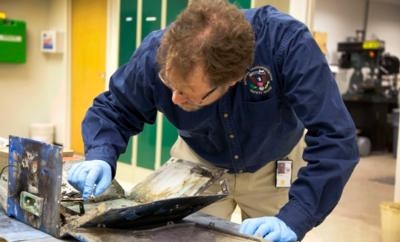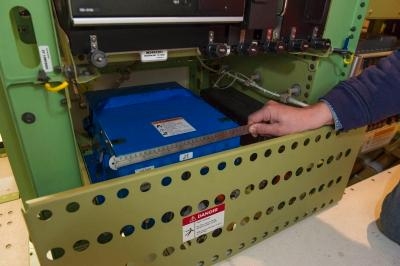Recommends Process Improvements For Certifying Lithium-Ion Batteries
Shortcomings in design and certification ultimately led to the fire in a lithium-ion battery installed on a Boeing 787 jetliner that had just completed an intercontinental flight to Boston, the NTSB determined in its final report on the incident, which was released Monday.

On January 7, 2013, ground workers discovered smoke and flames coming from an auxiliary power unit lithium-ion battery in a Japan Airlines 787 that was parked at the gate at Boston Logan International Airport. There were no injuries to any of the 183 passengers or 11 crewmembers that had already deplaned after flying from Tokyo’s Narita Airport. The battery was manufactured by GS Yuasa Corporation.
Early in the investigation, the NTSB said that the fire began after one of the battery’s eight cells experienced an internal short circuit leading to thermal runaway of the cell, which propagated to the remaining cells causing full battery thermal runaway. This condition caused smoke and flammable materials to be ejected outside the battery’s case and resulted in excessive heat and a small fire.
“The investigation identified deficiencies in the design and certification processes that should have prevented an outcome like this,” said NTSB Acting Chairman Christopher A. Hart. “Fortunately, this incident occurred while the airplane was on the ground and with firefighters immediately available.”
Because the APU and main lithium-ion batteries installed on the 787 represented new technology not adequately addressed by existing regulations, the FAA required that Boeing demonstrate compliance with special conditions to ensure that the battery was safe for use on a transport category aircraft.
Investigators said that Boeing’s safety assessment of the battery, which was part of the data used to demonstrate compliance with these special conditions, was insufficient because Boeing had considered, but ruled out, cell-to-cell propagation of thermal runaway (which occurred in this incident) but did not provide the corresponding analysis and justification in the safety assessment. As a result, the potential for cell-to-cell propagation of thermal runaway was not thoroughly scrutinized by Boeing and FAA engineers, ultimately allowing this safety hazard to go undetected by the certification process.

As a result of its findings, the NTSB is recommending that the FAA improve the guidance and training provided to industry and FAA certification engineers on safety assessments and methods of compliance for designs involving new technology.
“Through comprehensive incident investigations like this one, safety deficiencies can be uncovered and addressed before they lead to more serious consequences in less benign circumstances,” said Hart.”
NTSB investigators also identified a number of design and manufacturing concerns that could have led to internal short circuiting within a cell.
As a result of the investigation, the NTSB made 15 safety recommendations to the FAA, two to Boeing, and one to GS Yuasa.
“The aviation industry is continually benefiting from technological advances, and we are hopeful that the lessons learned in this investigation will further enhance the industry’s ability to safely bring those innovative technologies to market,” said Hart.
(NTSB images)
 Aero-News: Quote of the Day (12.18.25)
Aero-News: Quote of the Day (12.18.25) Classic Aero-TV: Viking Twin Otter 400--Bringing the DHC-6 Back Into Production
Classic Aero-TV: Viking Twin Otter 400--Bringing the DHC-6 Back Into Production NTSB Final Report: Rans Employee Flying Club Rans S-6ES Coyote II
NTSB Final Report: Rans Employee Flying Club Rans S-6ES Coyote II ANN FAQ: Submit a News Story!
ANN FAQ: Submit a News Story! ANN's Daily Aero-Term (12.18.25): Braking Action Advisories
ANN's Daily Aero-Term (12.18.25): Braking Action Advisories




